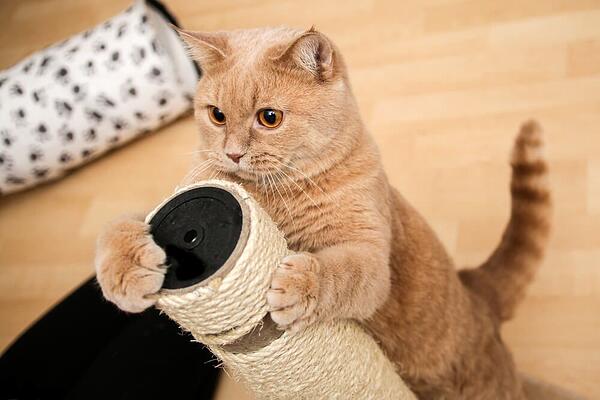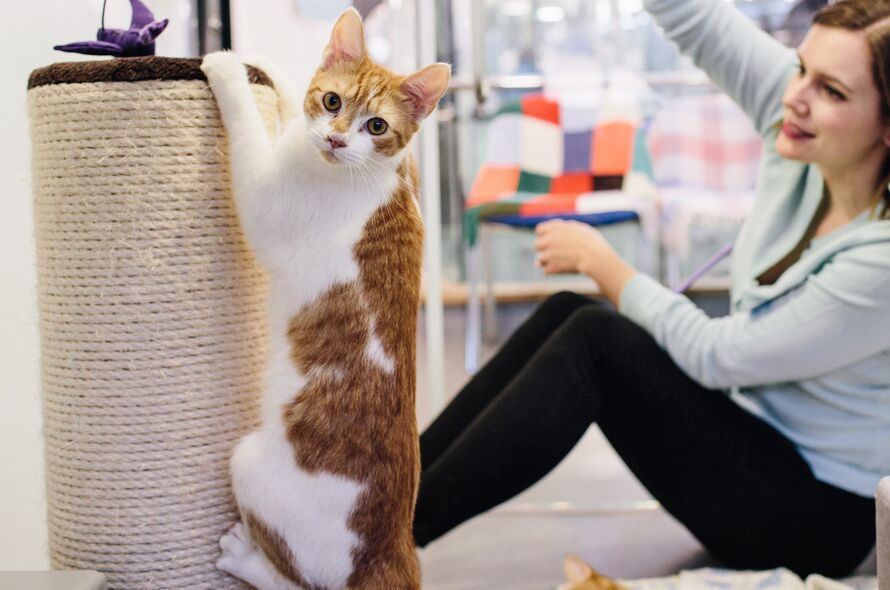Jacque Lynn Schultz, C.P.D.T., Companion Animal Programs Adviser. National Outreach
They serve as hooks, crampons, switchblades and chisels. A cat’s claws are the Swiss Army knife of the feline toolbox. They are essential in practically every role that a cat plays.

What’s the Use?
For the Predator, claws hold the prey while the mighty hunter positions himself to deliver the killing bite at the back of the neck. In play behavior, the claws grip a toy while the cat rubs against it or rakes it with his hind feet.
For the agile Climber, claws help Sir Hillary maneuver up and along trees, bookcases and upholstered furniture. When he sinks in his claws, they help him shift his body weight to attain proper balance and secure footing.
For the Communicator, claws facilitate leaving messages for other cats by scratching on surfaces. The claws engrave a visual territorial mark, while the scent glands in the paw pads brush on an olfactory mark.

Last, but not least, claws are a first line of defense for the Protector. If you have an older cat who has already made up her mind against manicures, the mummy method may serve you best. When a full-blown defense is required, she takes a position on her back with all four paws extended, claws ready for action.
Claws are indispensable! Yet, in many households, a cat and his claws are separated via surgical declawing – all for the sake of the sofa. While all cats need to scratch, few need to be declawed.
Manage the Damage
Most scratching needs can be met by providing suitable scratching and climbing surfaces. Sisal, fabric or rope-covered posts at least three feet tall on sturdy bases fill the bill for many felines. Owners who have extra space and money can meet a cat’s climbing and scratching needs with multi-level cat furniture, which incorporates resting and climbing platforms on tree trunk-type stilts.

If a cat doesn’t quickly catch on to your preferred scratching areas, a few incentives may help. Low-cost corrugated cardboard scratch boxes anointed with catnip can draw cats away from previously preferred sofa arms, especially if those arms are temporarily covered with industrial-strength plastic sheeting. Adding strips of double-stick masking tape over the plastic increases its repulsiveness to the cat. Double-sided sticky strips of plastic are also commercially available.
Solution in a Snip
Through the years, numerous individuals have called the ASPCA Behavior Helpline because they were considering declaw surgery. When asked how often they trim their cat’s nails, almost every caller has responded, “Never.” Coincidence? I think not! If claws are kept blunt, a cat who strays from the scratching post from time to time will do little to no damage. You, too, can get improved results without surgery by cutting the nails every two to three weeks.

- If you have never given a cat manicure, here are a few tips:
- If possible, start trimming the claws when your cat is young. As soon as kittens leave their littermates they are ready for nail trimming, so try to begin the routine no later than ten- to twelve-weeks of age.
- Make it pleasant. Initially, only trim several nails at a time. Offer a food reward or scratch the cat in his favorite spots; then let him go.
- If you can’t make it fun, make it fast. The one-paw swat is enough to send another cat out of preferred territory or to discipline the new dog. Wrap a thick towel around her, leaving only the head exposed. Bring out one paw at a time, trimming the nails as swiftly as possible.
- Some caretakers find they can abandon the towel method if they schedule the manicure after a meal. If the cat is groggy from an after-dinner snooze, she’ll be more relaxed and easier to handle.
Whatever your chosen technique, a set of sharp, well-made cat nail scissors is the tool of choice. Other equipment can do the job, but a pair of scissors may be the easiest to grasp when holding a squirming bundle of cat.
There’s no need to fear your feline’s nails. With a trimming regimen and the right equipment, you can happily co-exist with your cat’s arsenal.
Wondering about When Cats Don’t Get Along? Check it out on our latest post!
